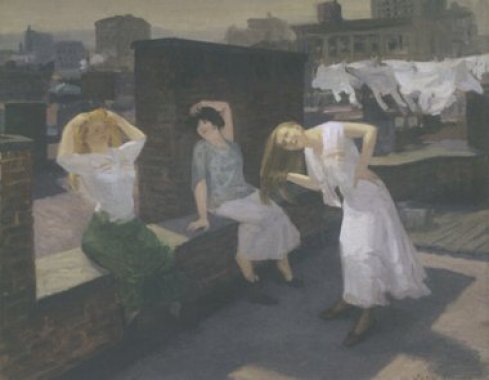Vast immensity of land, almost endless. A feeling of unfinished grandiosity leading to optimism. The American painters of the first half of the Nineteenth Century express the love for their homeland by means of strong wide brushstrokes driven by their vigorous pioneers’ spirit. They are part of the “Hudson River School” and they claim their own style to be distinctively American. Presented at the Guggenheim Foundation of Venice, as its second venue, Coming of Age is an exhibition that leads the visitors through more than a century of American creations. All the seventy-one works of art (paintings and sculptures) come from the Addison Gallery of American art founded by philanthropist Thomas Cochran in Andover, Massachusetts, in 1931. The whole collection is composed by more than 16.000 pieces, it offers a very complete representation of modern American art, ranging from the landscape painters of the Hudson River School to Abstract Expressionism.
Philip Rylands was directly in charge of the exhibition design which he wisely arranged in the newly refurbished gallery spaces according to a comprehensive but well-chosen selection. Each room has a very definite colour, that one may perceive as a direct emanation of the art itself. First Movement: Red wind from the West wraps around majestic landscapes. The hanging threat of “The Coming Storm” by Albert Bierstadt (George Innes will paint a more dramatic version of the same picture ten years later); “Mount Katahdin” by Frederic Church is gleaming and visionary, a close-up “Study of a Wood Interior” and the glowing elegy of “Fishing Boats on Low Tide” by Fitz H. Lane. Suddenly, on the right, a silver spell appears: the gloomy old bridge at Battersea commissioned by a Greek collector to the young Whistler, when the painter had already moved to London. The beginning of American art and its need to claim a unique identity is the core of the investigation of one of the two curators of the exhibition Susan C. Faxon: “what is truly American in American art?”. The answer could be found in the words of painter Asher B. Durand addressing his students in 1855:” Don’t go abroad looking for inspiration for your art, the still intact attractions of our homeland deserve nothing but your highest affections (…)”.
Nonetheless the interest for Europe will soon be unavoidable for these artists, affected by the irresistible pervasiveness of European aesthetic influences. Young Americans cannot ignore the old-country. In a complex dialogue of influences and exchanges they will try to find expressive means to overcome the naturalistic innocence characterising their “intact” creative background. Already around this time collectors and critics would go across the ocean to find new sources of inspiration. The exhibition is able to portray at best the anxiety to acquire new artistic inspirations. American artists will come across impressionism, post-impressionism, cubism and fauvism. Always devoted to their original themes, such as national pride, landscapes’ energy and vitalism, they will nonetheless learn the impressionist lesson free from prejudices. A group of artists at maturity will eventually move to Europe, the best known between them is John Singer Sargent. The artist was born in Europe, so he followed the same path of the fellow painters in reverse, coming back to his homeland at advanced age. Impressionist influences are recognizable in “Hemlock Pool” by John Henry Twatchman, in the “Valley of the Seine” by Theodore Robinson, the painter was Claude Monet’s neighbour in Giverny.
The crucial boost in American art can be clearly identified. The sharp eye of Alfred Stieglitz marks a turning point, in his gallery 291 a series of incredible exhibition anticipates the gigantic exhibition at the Armory Show in 1913, where the most advanced art experiences of the time meet. The XX Century is characterised by realism in the paintings of Robert Henry, George Bellows and John Sloan, culminating in the metaphysical realism of Edward Hopper represented in this exhibition by his puzzling “Manhattan Bridge Loop”. The coming of Modernism in the Thirties makes of New York the new centre for art, until the appearance of abstract expressionism with Franz Kline, Jackson Pollock and David Smith. The exhibition ends in the last elegantly balanced room dedicated to the Fifties.



